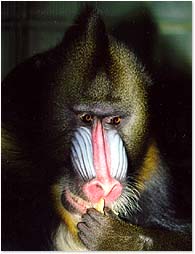

(primates)
The Primates are an ancient and diverse eutherian group, with around 233 living species placed in 13 families. Most dwell in tropical forests. The smallest living primate is the pygmy mouse lemur, which weighs around 30 g. The largest is the gorilla, weighing up to around 175 kg.
Primates radiated in arboreal habitats, and many of the characteristics by which we recognize them today (shortened rostrum and forwardly directed orbits, associated with stereoscopic vision; relatively large braincase; opposable hallux and pollex; unfused and highly mobile radius and ulna in the forelimb and tibia and fibula in the hind) probably arose as adaptations for life in the trees or are primitive traits that were retained for the same reason. Several species, including our own, have left the trees for life on the ground; nevertheless, we retain many of these features.
Primates are usually recognized based on a suite of primitive characteristics of the skull, teeth, and limbs. Some of these are listed above, including the separate and well-developed radius and ulna in the forearm and tibia and fibula in the hindleg. Others include pentadactyl feet and presence of a clavicle. Additional characteristics (not necessarily unique to primates) include first toe with a nail, while other digits bear either nails or claws, and stomach simple in most forms (sacculated in some leaf-eating cercopithecids). Within primates, there is a tendency towards reduction of the olfactory region of the brain and expansion of the cerebrum (especially the cerebral cortex), correlated with an increasing reliance on sight and increasingly complex social behavior.
The teeth of primates vary considerably. The dental formula for the order is 0-2/1-2, 0-1/0-1, 2-4/2-4, 2-3/2-3 = 18-36. The incisors are especially variable. In some forms, most incisors have been lost, although all retain at least 1 lower incisor. In others, the incisors are intermediate in size and appear to function as pincers or nippers, as they commonly do in other groups of mammals. In some, including most strepsirhines (see next paragraph), the lower incisors form a toothcomb used in grooming and perhaps foraging. In the aye-aye (Daubentoniidae), the incisors are reduced to 1 in each jaw and are rodent-like in form and function. Canines are usually (but not always) present; they vary in size, including within species between males and females. Premolars are usually bicuspid (bilophodont), but sometimes canine-like or molar-like. Molars have 3-5 cusps, commonly 4. A hypocone was added early in primate history, and the paraconid was lost, leaving both upper and lower teeth with a basically quadrate pattern. Primitively, primate molars were brachydont and tuberculosectorial, but they have become bunodont and quadrate in a number of modern forms.
Living primates are divided into two great groups, the Strepsirhini and the Haplorhini. Strepsirhines have naked noses, lower incisors forming a toothcomb, and no plate separating orbit from temporal fossa. The second digit on the hind foot of many strepsirhines is modified to form a "toilet claw" used in grooming. Strepsirhines include mostly arboreal species with many primitive characteristics, but at the same time, some extreme specializations for particular modes of life. Haplorhines are the so-called "higher" primates, an anthropocentric designation if ever there was one. They have furry noses and a plate separating orbit from temporal fossa, and they lack a toothcomb. Haplorhines include many more species, are more widely distributed, and in most areas play a more important ecological role. Haplorhines are further divided into two major groups, the Platyrrhini and the Catarrhini. Platyrrhines have flat noses, outwardly directed nasal openings, 3 premolars in upper and lower jaws, anterior upper molars with 3 or 4 major cusps, and are found only in the New World (families Cebidae and Callitrichidae). Catarrhines have paired downwardly directed nasal openings, which are close together; usually 2 premolars in each jaw, anterior upper molars with 4 cusps, and are found only in the Old World (Cercopithecidae, Hylobatidae, Hominidae).
Most primate species live in the tropics or subtropics, although a few, most notably humans, also inhabit temperate regions. Except for a few terrestrial species, primates are arboreal. Some species eat leaves or fruit; others are insectivorous or carnivorous.
Here, we follow Anderson and Jones (1984) in formally dividing living primates into two suborders, the Strepsirhini and the Haplorhini. We differ, however, in that we place humans and their close relatives, the chimpanzee, gorilla, and orang in the family Hominidae.
Suborder Strepsirhini Family Lemuridae (lemurs) Family Cheirogaleidae (dwarf lemurs, mouse lemurs) Family Indridae (indrisoids, avahis, sifakas, indris) Family Daubentoniidae (aye-aye) Family Galagonidae (galagos, bushbabies) Family Loridae (lorises, slow lorises, pottos, angwantibos) Family Megaladapidae (sportive lemurs or weasel lemurs) Suborder Haplorhini Family Tarsiidae (tarsiers) Family Cebidae (cebids, including capuchin monkeys, howlers, many others) Family Cercopithecidae (Old World monkeys and baboons, and many others) Family Callitrichidae (marmosets, tamarins) Family Hylobatidae (gibbons and siamangs) Family Hominidae (chimpanzees, gorillas, orangutans, humans)<<<<<<<>>>>>>> ARTIODACTYLA CARNIVORA CETACEA CHIROPTERA DASYUROMORPHIA DERMOPTERA DIDELPHIMORPHI DIPROTODONTIA HYRACOIDEA INSECTIVORA LAGOMORPHA MACROSCELIDEA MICROBIOTHERIA MONOTREMATA NOTORYCTEMORPHIA PAUCITUBERCULATA PERAMELEMORPHIA PERISSODACTYLA PHOLIDOTA PRIMATES PROBOSCIDEA RODENTIA SCANDENTIA SIRENIA TUBULIDENTATA XENARTHRA
Email: eradani7@aol.com